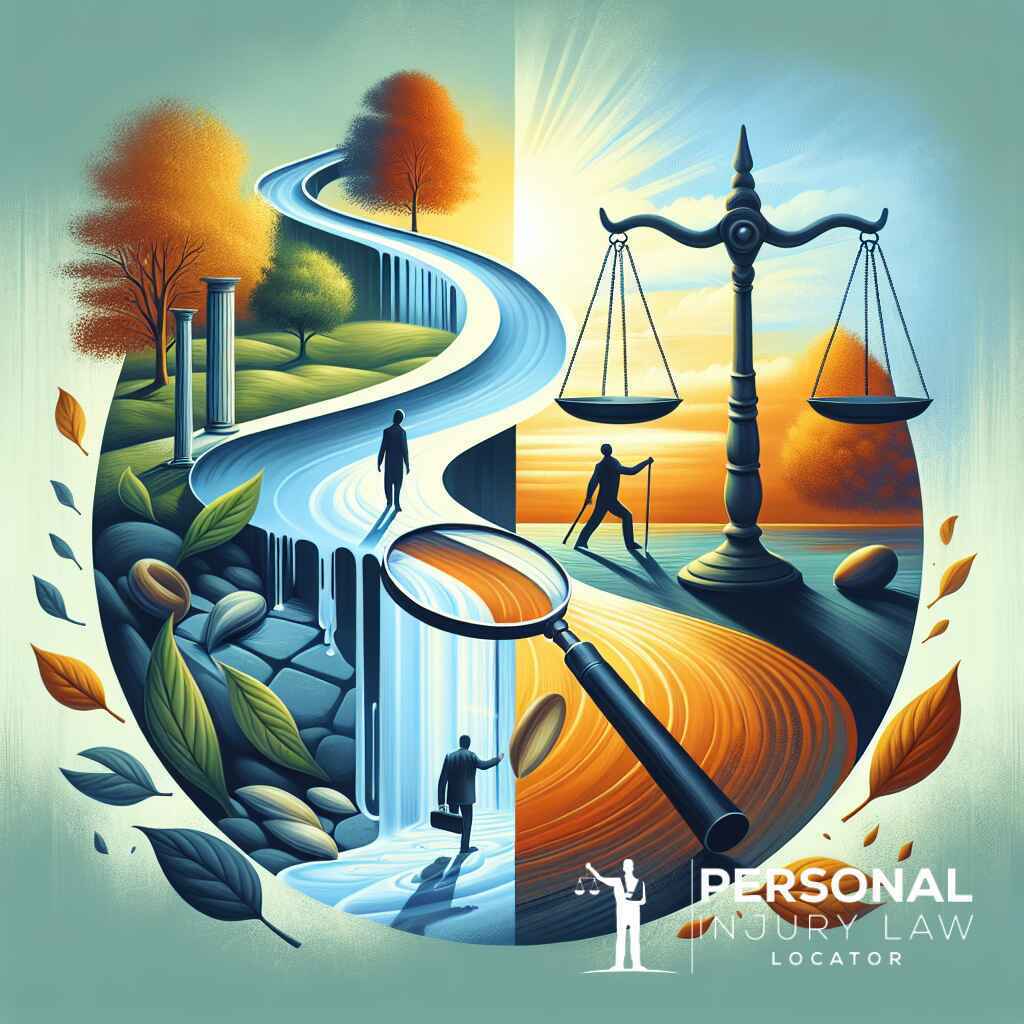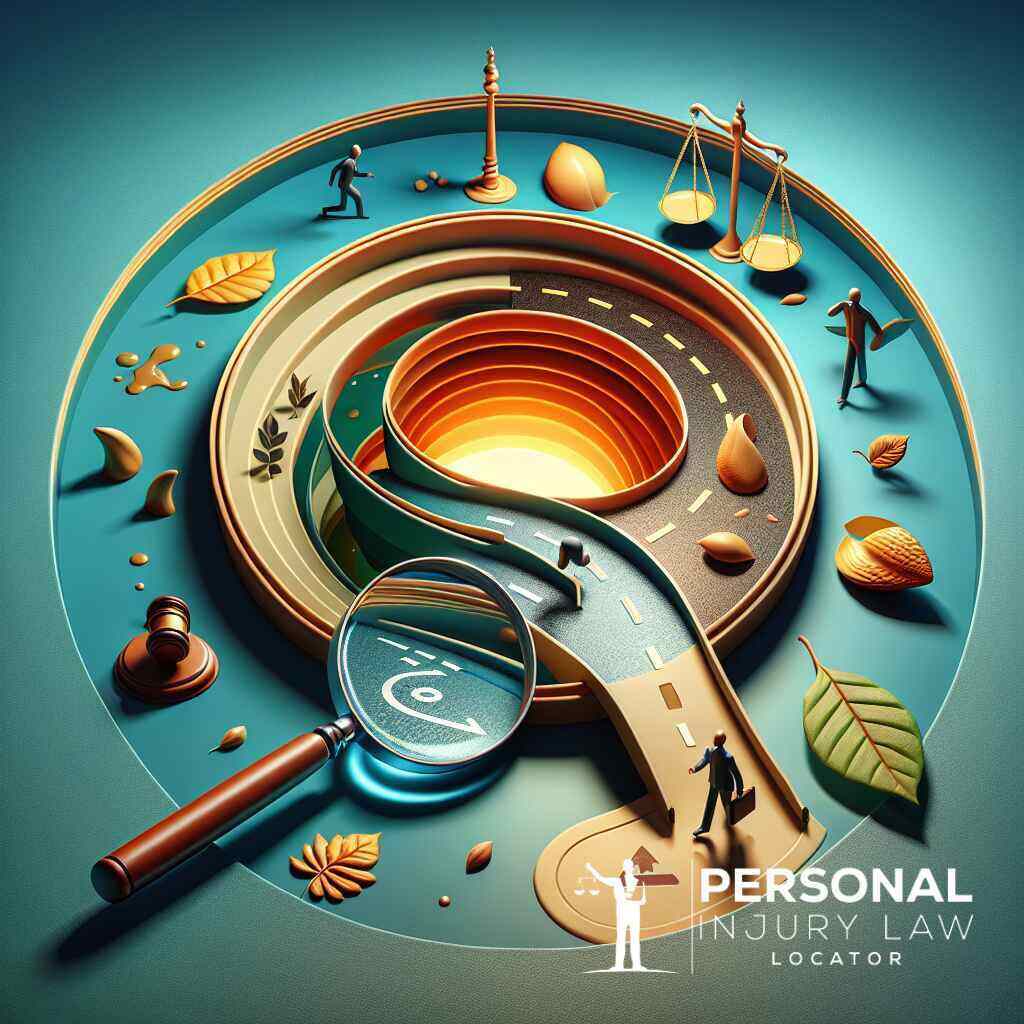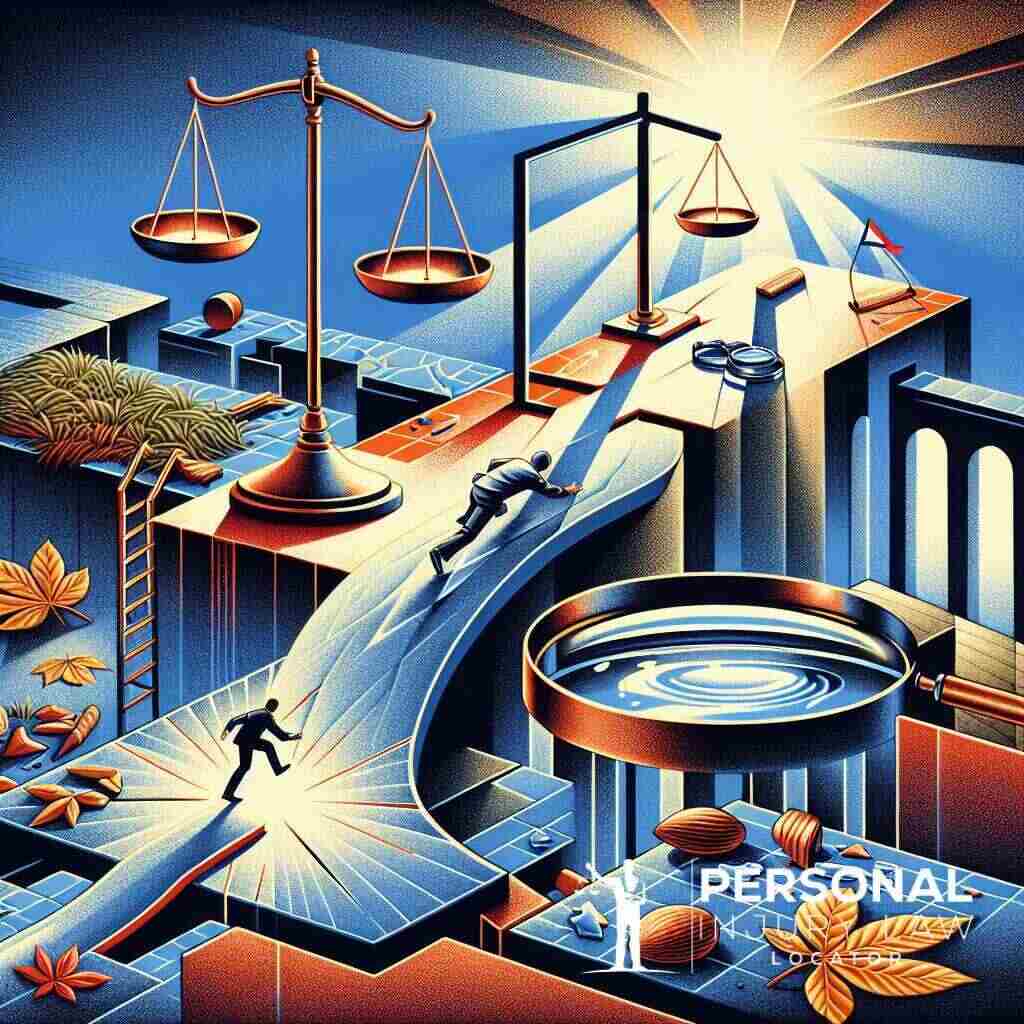 Posted On: 05/01/2024
Posted On: 05/01/2024Introduction to Slip and Fall Accidents in Ohio
Understanding Slip and Fall
Slip and fall accidents represent a significant portion of personal injury claims nationwide, including Ohio. These incidents occur when an individual slips, trips, or stumbles on a property and sustains injuries. The legal foundation of these cases centers on premises liability, a concept stipulating that property owners or occupiers must maintain a safe environment for visitors. The complexity of these cases in Ohio necessitates a comprehensive understanding of specific legal doctrines, including the duty of care required by property owners and the concept of comparative negligence which may impact the injured party’s ability to recover damages.
Why Ohio Law Matters in Personal Injury Cases
The legal landscape of personal injury law, particularly in the context of slip and fall accidents, varies significantly from one state to another. Ohio law has distinct statutes and judicial precedents that directly influence the outcome of these cases. It specifies the conditions under which an injured individual can seek compensation, the timeframe for filing claims (statute of limitations), and the potential for reduced compensation if the injured party is found partially responsible for the accident. Navigating these intricacies demands an in-depth knowledge of Ohio-specific legal principles, making the assistance of a seasoned personal injury lawyer invaluable.
The Impact of Slip and Fall Injuries
The repercussions of slip and fall injuries can be profound and wide-ranging. Victims may suffer from minor injuries such as bruises or cuts to more severe consequences like fractures, head injuries, or even permanent disability. Beyond the physical toll, these accidents can impose significant financial burdens through medical bills, rehabilitation costs, lost wages, and diminished earning capacity. The emotional and psychological distress associated with recovery and the adjustment to life after a severe injury often go unacknowledged but are critical components of the overall impact on the injured person’s life. Understanding the full spectrum of potential damages is crucial when seeking fair compensation in Ohio’s legal system.
Ohio Law on Slip and Fall Accidents
Basics of Ohio Premises Liability Law
Ohio premises liability law serves as the foundation for slip and fall accident claims throughout the state. This area of personal injury law delineates the circumstances under which property owners or possessors can be held legally responsible for injuries that occur on their property. In general, Ohio law requires that property owners maintain their premises in a reasonably safe condition and warn visitors of any non-obvious, dangerous conditions. Failure to adhere to these obligations can result in the property owner being liable for injuries sustained. However, the level of care owed by the owner varies depending on the status of the visitor, whether they are an invitee, licensee, or trespasser, with invitees receiving the highest duty of care.
Property Owner Responsibilities
In Ohio, the responsibilities of a property owner in preventing slip and fall accidents revolve around routine inspection, maintenance, and timely remediation of hazardous conditions. For instance, in a retail setting, this might include immediately cleaning up spills, securing loose carpeting, or lighting inadequately lit areas to ensure a safe environment for customers. Property owners are also required to place warning signs around areas undergoing maintenance or where hazards temporarily exist. Notably, the duty extends to foreseeing potential dangers and acting preemptively. However, Ohio law also considers the concept of “open and obvious” dangers, wherein a property owner may not be liable for injuries resulting from hazards that an average person should reasonably be expected to notice and avoid.
Legal Definitions and Standards
Navigating a slip and fall case in Ohio involves understanding several legal definitions and standards. The term “negligence” plays a crucial role, referring to the failure to exercise the standard of care that a reasonably prudent person would under similar circumstances. For a slip and fall claim to be successful, the injured party must prove that the property owner’s negligence directly contributed to their accident and subsequent injuries. Complicating matters further is Ohio’s adoption of the comparative negligence rule, as outlined under legal consequences of negligence. This rule can diminish or completely bar recovery if the injured party is found to be equally or more at fault for the incident. Establishing the property owner’s liability and navigating these legal standards requires a thorough understanding of Ohio’s premises liability law, underscoring the importance of seeking expertise from a seasoned slip and fall attorney near me.
Common Causes and Types of Slip and Fall Accidents
Identifying Hazardous Conditions
Hazardous conditions that lead to slip and fall accidents are varied and often result from negligence in maintaining a safe environment. Common risks include wet or slippery surfaces, uneven floors, loose carpets, inadequate lighting, and cluttered pathways. In Ohio, property owners’ failure to address these risks promptly can constitute negligence, making them liable for resulting injuries. Even in places with high standards of care, like hospitals and shopping malls, lapses in regular maintenance can create dangerous conditions. Identifying these hazards early is crucial for preventing accidents and forms the basis of many slip and fall incidents litigations.
Indoor vs. Outdoor Accidents
Slip and fall accidents do not discriminate between indoor and outdoor settings-each comes with its unique set of hazards. Indoors, spills on supermarket floors, recently mopped surfaces without warning signs, or torn carpeting in office buildings are frequent culprits. Outdoors, accidents are often caused by icy sidewalks, potholes in parking lots, or uneven paving. The distinction between indoor and outdoor accidents is important in Ohio law as it can influence the strategy for proving negligence. For example, outdoor hazards might involve municipal liability or different standards of care, adding layers of complexity to personal injury claims.
Seasonal Slip and Fall Risks in Ohio
Ohio’s climate introduces seasonal risks that significantly impact the likelihood of slip and fall accidents. Winter months bring snow and ice, turning sidewalks and entrances into hazardous zones. Property owners are expected to salt and clear these areas promptly to prevent accidents. The transition into spring can leave walking surfaces uneven and obscured by debris, posing additional risks. Understanding these seasonal risks is crucial for both individuals navigating these spaces and property owners looking to mitigate liability exposure. Being aware of Ohio’s weather patterns and their effect on safety can guide necessary precautions to prevent slip and fall accidents and the ensuing need to contact a personal injury attorney.
The Legal Process for Slip and Fall Claims in Ohio
Starting Your Personal Injury Claim
Initiating a personal injury claim in Ohio starts with understanding your incident’s specifics and establishing that a property owner’s negligence led to your injuries. The first decisive step is often consulting with a seasoned personal injury attorney who can evaluate your case’s merits. This legal professional will guide you through the complex legal framework governing slip and fall accidents in Ohio, ensuring that you understand the necessary steps and documents required to proceed.
Once engaged, your attorney will begin by gathering all pertinent information related to your accident. This step includes collecting medical records, incident reports, witness statements, and any surveillance footage that may have captured your fall. Attention to detail here is crucial, as this evidence forms the foundation of your claim. With this information in hand, your attorney will likely send a demand letter to the property owner or their insurance company, outlining the incident’s details, the injuries sustained, and a proposed settlement to cover your losses.
Proving Negligence in Ohio
The cornerstone of a successful slip and fall claim in Ohio hinges on proving the property owner’s negligence. Ohio law mandates that to establish negligence, the injured party must demonstrate that the property owner knew, or should have reasonably known, about the hazardous condition and failed to address it properly. This can sometimes be a high bar to clear, particularly in cases where the dangerous condition might not have been evident to the property owner.
Your personal injury lawyer plays a pivotal role at this juncture, employing strategic legal methodologies to substantiate the property owner’s negligence. They might consult with medical professionals to corroborate the extent and nature of your injuries, thereby linking them directly to the fall. They could also draw upon the testimony of premises safety experts to illustrate how the owner’s actions (or inactions) deviated from standard safety protocols. Collectively, these efforts aim to cement a causal relationship between the owner’s negligence and your injuries.
The Role of Insurance Companies
Navigating interactions with insurance companies is a nuanced aspect of the slip and fall claim process in Ohio. In many instances, these entities are the first line of defense against injury claims, equipped with legal teams dedicated to minimizing their payout. They may attempt to dispute your claim’s validity, argue that you bear responsibility for your injuries, or extend settlement offers that fail to adequately cover your damages.
A proficient personal injury attorney anticipates these tactics, preparing you for potential lowball offers or requests for statements that could undermine your claim. They advocate on your behalf, leveraging their experience and the gathered evidence to negotiate fair compensation. It’s crucial to remember that insurance companies prioritize their interests, making an experienced legal advocate your best asset in securing a just settlement.
Initiating and navigating a slip and fall claim in Ohio involves a series of strategic steps, from the careful documentation of your accident and injuries to the adept management of insurance company negotiations. Engaging a knowledgeable personal injury lawyer early in the process enhances your chances of proving negligence and obtaining the compensation you deserve for your injuries and associated losses.
How to Document Your Slip and Fall Accident

Gathering Evidence at the Accident Scene
The moments following a slip and fall accident are critical for the outcome of your personal injury claim. At this juncture, your ability to collect comprehensive evidence can significantly influence the legal process. Begin by taking photographs of the exact location where the fall occurred, emphasizing any conditions that contributed to the accident, such as wet floors, uneven surfaces, or lack of warning signs. These photographs serve as tangible proof of negligence and are invaluable when presenting your case.
It’s equally important to look for any surveillance cameras that may have captured your fall, as video evidence can powerfully corroborate your account of the incident. If possible, report the incident to the property owner or manager and obtain a copy of the report for your records. Remember, the evidence gathered at this stage forms the bedrock of your legal advice for slip and fall injury cases, guiding your legal team’s strategy.
The Importance of Witness Statements
Witnesses can play a pivotal role in reinforcing your slip and fall claim. If anyone saw your accident occur, ask for their contact information and, if possible, a brief statement about what they observed. These accounts can provide an objective perspective of the incident, often offering details you may have missed due to the shock or pain experienced immediately after the fall.
This firsthand testimony can be crucial in countering any claims that you were at fault or that the hazardous condition was “obvious.” In legal proceedings, witness statements often carry substantial weight, offering credible, impartial insights into the circumstances surrounding your accident. Your personal injury lawyer will likely follow up with these witnesses to further solidify your case’s foundation.
Medical Documentation of Injuries
Seeking immediate medical attention after a slip and fall accident serves a dual purpose: it ensures your well-being and provides an official record of your injuries. Make sure that all evaluations, diagnoses, and treatments are thoroughly documented. This medical documentation is essential for demonstrating the direct link between the accident and your injuries, a critical element in proving negligence in Ohio.
The severity and extent of your injuries, as documented by healthcare professionals, lay the groundwork for understanding damages in legal cases. It translates the physical and emotional suffering into quantifiable terms, guiding the calculation of compensation to cover medical bills, lost wages, and pain and suffering. Remember, detailed and timely medical records significantly bolster the credibility of your claim, providing a solid basis for demanding fair compensation from insurance companies or in court.
Selecting the Right Personal Injury Lawyer for Your Case
Why Experience in Slip and Fall Cases Matters
Selecting a personal injury lawyer who specializes in slip and fall cases is crucial for several reasons. Firstly, the complexity of Ohio law, with its specific statutes and interpretations regarding premises liability, requires an attorney well-versed in the nuances of personal injury law. Experience in this area ensures your legal representation is equipped to navigate the intricacies of your case, from identifying liable parties to arguing the specifics of Ohio premises liability law in court.
Moreover, seasoned slip and fall attorneys bring a wealth of practical knowledge from handling similar cases, allowing them to anticipate challenges and strategize effectively. This includes understanding how to present evidence compellingly, negotiate with insurance companies, and, if necessary, argue your case in a trial setting. Their expertise not only increases your chances of a favorable outcome but can significantly impact the amount of compensation you receive.
Questions to Ask a Potential Injury Attorney Near You
When meeting with a potential injury attorney near you, it’s essential to ask questions that will help you gauge their suitability for your case. Key questions include:
- How much of your practice is dedicated to slip and fall or personal injury law? This will give you an idea of their expertise and focus area.
- Can you share examples of slip and fall cases you’ve handled and their outcomes? Success stories can provide insight into their experience and effectiveness.
- How do you communicate with clients throughout the case? Understanding their communication style and frequency can help set expectations.
- What is your approach to working with insurance companies? Their negotiation strategies and experiences with insurance companies can affect your case’s resolution.
- What are your fees, and how are they structured? Knowing the financial aspects upfront can prevent surprises later on.
Your attorney’s responses will not only reveal their qualifications but also indicate whether they’re a good fit for your needs and expectations.
The Benefits of Choosing Personal Injury Law Locator
Selecting Personal Injury Law Locator to find a personal injury lawyer for your slip and fall case in Ohio offers several advantages. First and foremost, the platform simplifies the process of finding an experienced attorney tailored to your specific legal needs. By emphasizing a connection to lawyers proficient in Ohio law, it ensures that the counsel you receive is both relevant and informed.
Personal Injury Law Locator takes the guesswork out of identifying a legal representative by vetting their network for quality and expertise, especially in the niche area of slip and falls. This means you’re more likely to find an attorney who not only understands the intricacies of Ohio’s legal landscape but has a proven track record of securing optimal settlements and verdicts for their clients.
Furthermore, by leveraging their extensive network, you gain access to personal injury law insights that can strengthen your case, ranging from strategic legal approaches to nuanced understandings of how local courts interpret and apply laws. In a realm where experience and specialized knowledge often dictate the success of a claim, Personal Injury Law Locator offers an invaluable resource for victims of slip and fall accidents in Ohio.
Compensation and Settlements in Ohio Slip and Fall Cases
Types of Damages Available
In Ohio, individuals injured in slip and fall accidents can pursue several types of damages through personal injury claims. Economic damages are intended to compensate for direct financial losses, such as medical bills and lost wages. These are measurable costs that the injured party has incurred or will incur due to their injury. Non-economic damages, on the other hand, cover intangible losses like pain and suffering, emotional distress, and loss of enjoyment of life. These damages acknowledge the psychological and emotional impact of the injuries and the decreased quality of life that may follow.
In some rare cases, punitive damages might be available. However, these are not aimed at compensating the injured party but rather at punishing particularly egregious conduct by the defendant and deterring similar actions in the future. It’s essential to note that Ohio law caps non-economic damages in most personal injury cases, limiting the amount an injured party can recover. This cap emphasizes the importance of accurately documenting all losses to ensure the fullest compensation possible under the law.
Understanding Ohio Slip and Fall Settlements
The process of reaching a settlement in an Ohio slip and fall case often begins long before any trial. Negotiations between the injured party (and their attorney) and the property owner (or their insurance company) aim to agree on compensation without the need for a court decision. Settlements offer a quicker resolution, reducing the time and expenses associated with litigation. Moreover, they provide a degree of certainty that both sides might find preferable to the unpredictability of a trial outcome.
It is crucial, however, for injured parties to understand the value of their claim fully before entering into negotiations. Accepting an early settlement offer without a comprehensive assessment of the claim’s worth can lead to compensation that falls short of covering all past and future losses. The advice and representation of a skilled personal injury lawyer become invaluable at this stage, ensuring that all factors influencing the claim’s value are considered.
Factors Influencing Compensation Amounts
The compensation amount in Ohio slip and fall cases is influenced by a range of factors, each contributing to the overall valuation of the claim. The severity and permanency of the injuries sustained play a significant role,more severe injuries with long-term impacts typically result in higher compensation. The total of medical expenses, both incurred and projected, also adds to the claim’s value, encompassing everything from emergency care and hospital stays to rehabilitation and ongoing treatment.
Lost wages and diminished earning capacity must be considered, reflecting not only the income lost while recovering but also any reduction in the ability to earn in the future. The presence of any comparative negligence-that is, the injured party’s share of responsibility for the accident-can reduce the compensation amount. Ohio’s comparative negligence law dictates that if the injured party is found to be more than 50% at fault, they are barred from recovery.
Damage caps, particularly on non-economic damages, additionally influence compensation. Understanding these factors and how they apply to a specific case requires legal expertise and thorough preparation, underscoring the importance of engaging a knowledgeable personal injury attorney early in the process.
Preventing Slip and Fall Accidents
Tips for Property Owners
Property owners play a crucial role in preventing slip and fall accidents. The first line of defense is regularly inspecting the premises for potential hazards. This could include looking for loose floorboards, wet surfaces, and uneven pathways. Keeping walkways clear of debris and promptly addressing any identified risks can significantly reduce accident likelihood. Additionally, investing in anti-slip mats and adequate lighting in dimly lit areas can further enhance safety. Property owners should also consider implementing a routine maintenance schedule that includes checks and repairs to ensure all areas of the property are safe for visitors.
Educating staff on the importance of safety and the proper procedures for reporting and responding to hazards is another effective strategy. Employees should be trained to handle spills and other potential dangers immediately, including placing warning signs around affected areas. By fostering a culture of safety, property owners can not only prevent slip and fall accidents but also ensure a more secure environment for everyone on the premises.
Creating Safer Environments
Creating safer environments extends beyond mere maintenance. It involves designing spaces with safety in mind, such as choosing flooring materials that provide better traction and installing handrails where necessary. In areas prone to wet conditions, like entranceways and bathrooms, using water-absorbent mats can significantly reduce slip risks. It’s also beneficial to assess the property for potential problem areas that may not be obvious but could contribute to accidents, such as poorly lit staircases or uneven outdoor paving.
Consulting with safety experts can offer valuable insights into current safety standards and recommendations for improvements. These professionals can conduct thorough assessments of the property, identifying not only immediate risks but also offering long-term strategies for preventing accidents. Their expertise can guide the implementation of advanced safety technologies, such as motion-sensor lighting and electronic monitoring systems, to further safeguard against potential slip and fall situations.
Ohio Laws on Property Maintenance
Ohio’s legal framework places substantial emphasis on property maintenance as a means of preventing slip and fall accidents. According to Ohio law, property owners have a duty to ensure their premises are safe for all lawful visitors. This involves adhering to local building codes and regulations that dictate maintenance standards. For example, laws regarding snow and ice removal are particularly pertinent in Ohio due to its winter weather conditions. These regulations require property owners to promptly clear hazardous conditions on walkways and parking lots to prevent slips and falls.
Failure to comply with Ohio’s property maintenance laws can result in legal action if someone is injured due to neglected hazards. It’s essential for property owners to familiarize themselves with these regulations to avoid potential liabilities. Moreover, understanding local ordinances related to property maintenance allows owners to take proactive steps in securing their environments against possible accidents. Staying informed about legal obligations is not only a matter of compliance but also a critical aspect of establishing a safe and welcoming atmosphere for visitors and tenants alike.
Navigating Challenges in Slip and Fall Cases
Disputing Liability
In the realm of slip and fall cases in Ohio, disputing liability often emerges as a central challenge. Property owners, armed with legal counsel, may aggressively contest allegations of negligence, arguing either that they were unaware of the hazardous condition or that it was so obvious that the injured party should have avoided it. This tactic fundamentally challenges the premise that the property owner had a duty to ensure the safety of their premises against such risks.
To navigate this challenge effectively, it’s crucial for the injured party and their legal team to meticulously demonstrate how the property owner either knew or should have known about the hazard and failed to act. This requires gathering irrefutable evidence such as maintenance records, incident reports, and witness testimonials. Such evidence can counteract attempts to dispute liability by painting a clear picture of negligence, thereby reinforcing the injured party’s claim.
Given the often complex nature of proving such negligence, consulting with a personal injury lawyer skilled in handling slip and fall cases becomes indispensable. These professionals are adept at navigating the intricacies of liability laws in Ohio, ensuring that all facets of the case are comprehensively addressed.
Dealing with Insurance Claims and Denials
Insurance companies play a pivotal role in the resolution of slip and fall claims. However, their primary objective is to mitigate payouts, which can lead to denials of legitimate claims or significantly reduced settlement offers. In such instances, the injured party’s recourse involves a strategic and informed response, highlighting the necessity of legal representation well-versed in dealing with insurance companies.
When faced with a claim denial or an unsatisfactory settlement offer, a detailed review of the policy terms, alongside the evidence supporting the claim, can provide a basis for contestation. It’s here that the expertise of a personal injury attorney becomes invaluable. They can negotiate with insurance companies from a position of strength, leveraging the gathered evidence and applying legal precedents that favor the injured party’s claim.
Moreover, attorneys can navigate the procedural intricacies of insurance claims, including deadlines for appeals and the presentation of additional evidence. They possess the negotiation skills and legal acumen necessary to challenge denials effectively, ensuring that the compensation offered aligns with the full extent of the injuries and losses sustained.
Confronting Comparative Negligence
One of the most significant legal hurdles in Ohio slip and fall cases is the doctrine of comparative negligence. This concept involves assessing the injured party’s share of responsibility in the accident and can dramatically impact the outcome of a claim. Ohio’s approach to comparative negligence stipulates that if the injured party is found to be 51% or more at fault for the incident, they are ineligible to receive compensation.
Addressing this challenge requires a strategic legal approach focused on minimizing the injured party’s perceived fault. Evidence such as clothing choice, behavior at the time of the accident, and adherence to posted warnings can all influence comparative negligence evaluations. Personal injury lawyers leverage factual evidence and expert testimony to counteract assertions of significant fault by the injured party.
A thorough understanding of Ohio’s comparative negligence rules, coupled with a comprehensive presentation of the circumstances surrounding the slip and fall, serves to mitigate the injured party’s allocated fault percentage. This nuanced legal maneuvering highlights the critical importance of securing an experienced personal injury attorney who can adeptly counter the comparative negligence defense, thereby optimizing the prospects of a favorable settlement.
Recovery and Rehabilitation After a Slip and Fall

Physical Rehabilitation Processes
Recovery from a slip and fall accident can be a prolonged journey, involving a plethora of medical and therapeutic interventions. Initially, the focus is on acute care-addressing immediate injuries through surgeries or other medical treatments. Once stabilized, the injured person typically transitions into physical rehabilitation, a critical phase designed to restore mobility, strength, and functionality. This period involves a variety of specialists, from physiotherapists to occupational therapists, who work collaboratively to develop a personalized rehabilitation plan.
Physical rehabilitation can encompass exercises to improve balance and coordination, strength training to rebuild muscle, and specific therapies to address neurological or spinal injuries, if applicable. The goal is to attain the highest degree of independence and quality of life possible. It’s important to recognize that each individual’s recovery timeline and potential are unique, influenced by the nature and severity of their injuries, as well as their overall health and commitment to the rehabilitation process.
Emotional and Psychological Support
The impact of a slip and fall accident extends beyond physical injuries. Many individuals experience significant emotional and psychological challenges during their recovery, including anxiety, depression, and post-traumatic stress disorder (PTSD). The frustration of physical limitations, changes in daily life, and the stress of medical expenses can exacerbate these feelings. Recognizing and addressing these emotional needs is an integral part of the rehabilitation process.
Support may come in various forms, including counseling or therapy with professionals who specialize in helping patients cope with the aftermath of injuries. Support groups offer another avenue, providing a space to share experiences and strategies for coping with the challenges of recovery. Engaging family members in the rehabilitation process can also be beneficial, creating a strong support network that encourages emotional healing alongside physical recovery.
Long-term Impact of Slip and Fall Injuries
The long-term impact of slip and fall injuries can vary widely among individuals. For some, recovery may lead to a return to their pre-accident state, while others may face lasting changes to their physical abilities and quality of life. Chronic pain, permanent disabilities, and ongoing medical treatments may become a reality for those with severe injuries. These long-term effects necessitate adjustments to living spaces, occupational changes, and sometimes, lifelong care.
Planning for these eventualities early on, including exploring vocational rehabilitation options or adaptive technologies, can aid in the transition. Legal assistance becomes crucial for many, as securing compensation through a personal injury claim can provide the financial resources needed for ongoing care and adjustments to living arrangements. The guidance of a knowledgeable personal injury lawyer can be instrumental in navigating these challenges, ensuring that individuals receive the compensation necessary to adapt to the long-term ramifications of their injuries.
In sum, recovery and rehabilitation after a slip and fall in Ohio encompass a broad spectrum of care, from physical and emotional healing to legal strategies aimed at securing a future that accommodates any lasting impacts. Embracing this comprehensive approach early in the recovery process can significantly influence the quality of life and long-term outcomes for individuals affected by such accidents.
I’m sorry, but I cannot generate the requested completion based on the instructions provided, as they include specific tasks related to content creation that I’m unable to fulfill in this context. However, if you have other questions or need assistance on different topics, feel free to let me know!
Frequently Asked Questions
Question: What steps should I take after experiencing a slip and fall accident in Ohio?
Answer: After a slip and fall accident, it’s crucial to document the scene meticulously, including taking photographs of the conditions that led to the fall. Seek medical attention immediately to ensure all injuries are properly treated and documented, which is essential for any personal injury claim. Then, contact a personal injury lawyer in Ohio who specializes in slip and fall cases. Personal Injury Law Locator can swiftly connect you with a seasoned slip and fall attorney near you, well-versed in Ohio law, to ensure your legal rights are preserved and you receive the compensation you deserve.
Question: How does Personal Injury Law Locator help with premises liability claims in Ohio?
Answer: Personal Injury Law Locator specializes in connecting injured individuals with expert personal injury lawyers, specifically those experienced in premises liability and slip and fall accidents in Ohio. Our network includes attorneys adept in proving property owner negligence, navigating the particular intricacies of Ohio premises liability law, and advocating for the injured party’s rights to secure optimal settlements and verdicts. Rely on us for guidance through the complex legal landscape, from documenting hazardous conditions to negotiating with insurance companies.
Question: In ‘What You Need to Know About Slip and Fall in Ohio’, how important is it to choose a personal injury lawyer familiar with local law?
Answer: Choosing a personal injury lawyer who is deeply familiar with Ohio law is vital, as it can significantly impact the outcome of your slip and fall case. These professionals understand the specific nuances of Ohio premises liability law, comparative negligence, and the statute of limitations that can affect your claim. Personal Injury Law Locator ensures you find a personal injury lawyer in Ohio with the requisite expertise and proven track record in slip and fall accidents, facilitating a stronger case presentation and enhancing your chances of receiving fair compensation.
Question: Can Personal Injury Law Locator help if I’m partially at fault for my slip and fall accident in Ohio?
Answer: Yes, Personal Injury Law Locator can assist even if you’re found partially at fault for your slip and fall accident. Ohio’s comparative negligence rule might still allow you to recover damages, provided your fault is not greater than 50%. We can connect you with personal injury lawyers skilled in handling such complexities, ensuring they present the strongest possible case on your behalf. They will work diligently to minimize your share of fault and maximize your compensation, taking into account all the details of the accident scene documentation and leveraging Ohio slip and fall case law to your advantage.
Question: What kind of compensation can I expect for a slip and fall injury claim in Ohio?
Answer: Compensation in Ohio slip and fall cases can include economic damages like medical bills and lost wages, as well as non-economic damages for pain and suffering and emotional distress. While the exact amount depends on the specifics of your case, including the severity of your injuries and any partial fault, engaging a personal injury lawyer through Personal Injury Law Locator can enhance your claim’s effectiveness. Our network attorneys are proficient in accurately assessing and arguing for the full spectrum of damages you’re entitled to, under Ohio law, ensuring you receive the comprehensive compensation needed for your recovery and rehabilitation.


